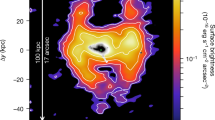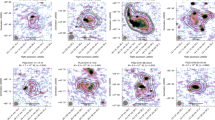Abstract
Kurth et al.1, using Voyager radio data and a simple model of solar-wind expansion, have inferred the location of the heliospheric shock to be 46 AU. Additional consideration of their data and the use of a modern model of the distant solar wind allow us to reduce this estimate to as little as 30 AU. The shock occurs where the solar wind pressure falls to that of the local interstellar medium (LISM). This value for the distance to the shock is less than half that usually expected, indicating that the parameters thought to describe the LISM differ from those commonly assumed. Provisionally accepting this interpretation, we applied a sophisticated model of solar-wind expansion to deduce a range of parameters for the LISM that predicts a comparable shock location. Specifically, we find that either the interstellar magnetic field is more than double the presently accepted value of 0.3 nT, or the pressure due to galactic cosmic rays with energies near 0.1 MeV is that obtained by simple extrapolation of the observed flux at higher energies inside the heliosphere, or some combination of these two external effects to yield an effective interstellar pressure approximately quadruple present estimates.
This is a preview of subscription content, access via your institution
Access options
Subscribe to this journal
Receive 51 print issues and online access
$199.00 per year
only $3.90 per issue
Buy this article
- Purchase on Springer Link
- Instant access to full article PDF
Prices may be subject to local taxes which are calculated during checkout
Similar content being viewed by others
References
Kurth, W. S., Gurnett, D. A., Scarf, F. L. & Poynter, R. L. Nature 312, 27–31 (1984).
Wallis, M. K. & Dryer, M. Astrophys. J. 205, 895 (1976).
Dessler, A. J. Rev. Geophys. 5, 1–41 (1967).
Schwenn, R. in Solar Wind Five (ed. Neugebauer, M.) 489–507 (NASA CP-2280, 1983).
Solar-Geophysical Data No. 470, Pt I (NOAA National Geophysical Data Center, Boulder, Colorado, October 1983).
Axford, W. I. in Solar Wind (eds Sonnett, C. P., Coleman, P. J. Jr & Wilcox, J. M.) 609–660 (NASA SP-308, 1972).
Holzer, T. E. J. geophys. Res. 77, 5407–5431 (1972).
Clarke, J. T., Bowyer, S., Fahr, H. J. & Lay, G. Astr. Astrophys. 139, 389–393 (1984).
Ajello, J., Thomas, G. & Stewart, A. EOS 65, 1069 (1984).
Slavin, J. A., Smith, E. J. & Thomas, B. T. Geophys. Res. Lett. 11, 279–282 (1984).
Suess, S. T., Thomas, B. T. & Nerney, S. F. J. geophys. Res. Lett. 2, 75–79 (1975).
Axford, W. I., Dessler, A. J. & Gottlieb, B. Astrophys. J. 137, 1268–1278 (1963).
Dessler, A. J. & O'Brien, B. J. in Satellite Environment Handbook 2nd edn (ed. Johnson, F. S.) (Stanford University Press, Palo Alto, 1965).
Wada, M. 18th int. Cosmic Ray Conf., Invited and Rapporteur Pap. 12, 389–402 (1983).
Author information
Authors and Affiliations
Rights and permissions
About this article
Cite this article
Suess, S., Dessler, A. Probing the local interstellar medium. Nature 317, 702–703 (1985). https://doi.org/10.1038/317702a0
Received:
Accepted:
Issue Date:
DOI: https://doi.org/10.1038/317702a0
This article is cited by
-
Gasdynamic structure of the heliosphere: Theory and experiment
Fluid Dynamics (1993)
-
Distribution of plasma turbulence in our Galaxy derived from radio scintillation maps
Nature (1992)
-
Frequency drift of 3-kHz interplanetary radio emissions: evidence of Fermi accelerated trapped radiation in a small heliosphere?
Nature (1990)
-
Sounding a small heliosphere
Nature (1990)
-
Gasdynamics of the solar wind interaction with the interstellar medium
Space Science Reviews (1990)
Comments
By submitting a comment you agree to abide by our Terms and Community Guidelines. If you find something abusive or that does not comply with our terms or guidelines please flag it as inappropriate.



